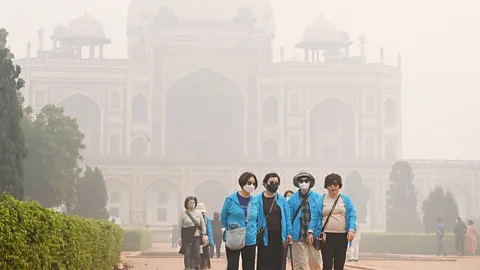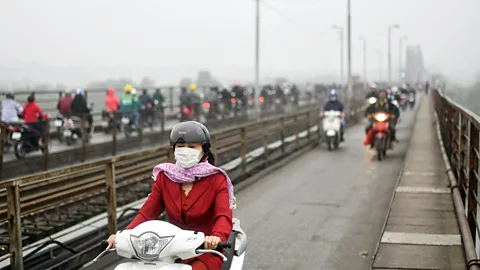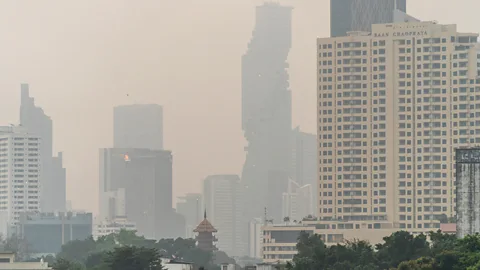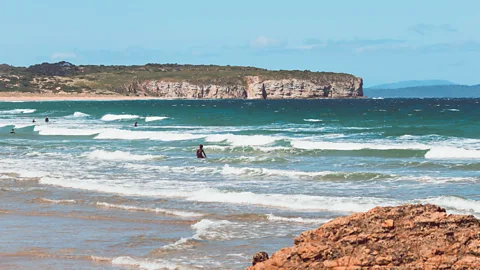 Getty Images
Getty ImagesAs New Delhi makes headlines yet again for its choking smog, experts and holidaymakers alike are pondering how worsening air quality will change travel in the long-term.
My first words during a Christmas trip to Hanoi last year did not bode well: “It looks like the set of Bladerunner.” I peered out of the airplane window, expecting to see Vietnam’s capital twinkling in the sunset. Instead, just like the 1982 dystopian sci-fi film, I was met with a blanket of grey, dirty mist smothering the city lights. A cautious traveller, I had double-checked my hotel bookings, taken out insurance, packed carefully. But there was one thing I hadn’t planned for: smog.
Luckily, Hanoi’s haze – which at the time reached “very unhealthy” levels on the Air Quality Index (AQI) – cleared eventually. But the first days were spent scrambling to buy air masks, squinting through low-level headaches and postponing leisurely walks to explore the lively streets.
Welcome to smog season
Many places see “toxic air seasons” as the new normal: a regrettable, unavoidable part of the calendar. Unfortunately, this drastic pollution may see visitors shunning countries entirely for those periods. End-of-year travel is a key time for holidays, but coincides in many destinations with colder temperatures that trap pollutants close to the ground.
Some nations worst-hit by smog also depend keenly on tourist dollars. Bangladesh, for example, was ranked fifth worst in the world for air quality in 2022 – yet 4.4% of the country’s GDP comes from tourism. Egypt, ranked ninth worst for air quality, relies on holidaymakers to support one in 12 local jobs.
 Getty Images
Getty ImagesAir power
Bryce Merkl Sasaki, a digital nomad who has travelled extensively in Southeast Asia, has seen several destinations marred over the past few years. “Smog was definitely an issue where we lived in Mae Sot [in Western Thailand]. Many times when we wanted to take a bicycle trip along the river, the air was so bad that we decided to stick inside,” he recalls. “Another time we cancelled a trip to Chiang Mai because the smog there was way above safe levels.”
Want to travel better? Thoughtful Travel is a series on the ways people behave while away, from ethics to etiquette and more.
When he moved to rural Cambodia as the marketing manager for a local arts school and circus, he struggled with recurring dust and haze. “As someone who worked in the tourism industry, I can say the smoggiest days definitely meant fewer tourists coming to the circus that night.”
With 6.5 million deaths attributed to bad air each year, the issue is now spotlit on global public health agendas. Apart from the obvious symptoms of respiratory diseases, exposure to air pollution is linked to higher risk of diabetes, obesity, cancer, infertility and even dementia.
Fresh air is such a commodity that it has even become a souvenir, with multiple countries, including Iceland, Italy and Canada, selling their canned local air to amused and envious visitors. (Ironically, these marketing stunts create an added carbon footprint from their manufacture, one that further worsens air quality.)
Solutions on the ground
So what can be done? Technology may come to the aid of our lungs, on a local level at least. A team at the Insight SFI Research Centre for Data Analytics at Dublin City University are developing an app that can map Dublin’s air pollution. The app will calculate routes allowing pedestrians and cyclists to adapt their journey, circumventing the more harmful pockets of the city. As the issue develops, tools like these may become everyday must-haves, at home and abroad.
 Getty Images
Getty ImagesMeanwhile, alarming air quality is already shifting consumers’ travel decisions, says Cathy Feliciano-Chon, managing partner, APAC at FINN Partners, a global marketing communications agency with a practice in travel and hospitality. “Especially now when experiences outdoors and in nature have become even more popular since the pandemic.” During this period billions of people, stuck in hotels, hospitals and homes, suddenly became aware of how the natural environment affected their mood.
A history of clean-air holidays
Our obsession with healthy air is nothing new. Victorian-era doctors prescribed “a change of air” to countless patients, encouraging a restful holiday away from grimy cities towards mountains, coastal resorts and invigorating sea voyages. In Britain, many of those resorts, such as Bournemouth and Torquay, remain popular getaways today.
Looking further back, an unhealthy atmosphere or “miasma” has been blamed for ill health since ancient times, so much so that the name for mosquito-borne malaria stems from “mala aria“, a Renaissance Italian term for “bad air”.
No wonder some hotels scrambled to add a specific line item to their budgets: industrial HVAC (heating, ventilation and air-conditioning) systems designed to kill on-site mould and dust. Other properties are targeting the bedroom: RH Guesthouse, a boutique hotel in New York, proudly offers the FreshBed, a US$50,000 piece of kit that wafts purified air through the mattress so guests can customise temperature and humidity levels for restorative sleep.
Travellers looking for air that beautifies can rest easy too. Cryotherapy, which exposes the body to extreme cold temperatures, now features in luxury spas, who tout the pure air’s ability to restore circulation to the skin of jet-lagged travellers. Victorian-era doctors would approve.
The future of “air” travel
Countries lucky enough to sit on prime real estate – brimming with clean air – are waking up to their commodities. A 2020 study by travel think tank TCI Research found that air quality is one of Europe’s top three key competitive selling points for tourists. And you can already see this theme cropping up in marketing campaigns around the globe. Tourism Canada’s 2023 campaign invited tourists to “take your maple leave”. The video ad features a cheerful Canuck by a windswept lighthouse, urging viewers to enjoy “a breath of fresh air in a world full of stress”.
 Alamy
AlamyThe same year, Australia’s Tourism Tasmania showcased their tranquil “Come Down for Air” campaign. One video featured no dialogue, just a lone swimmer diving into the waves, audio of the restless sea breeze and an ending line: “Walk-ins welcome.” Nor is their campaign slogan mere hot air – Tasmania’s atmosphere regularly ranks among the cleanest on the planet.
With an unsullied atmosphere increasingly desirable, holidaymakers are prepared to head for extremes. In its 2022-2023 summer season, Antarctica saw more than 100,000 visitors flood the continent for its pristine views, bracing wind and solitude. That number is expected to balloon. Some worry this will be the next of many hotspots to wrestle with overtourism.
“It is a top concern, and ecotourism taxes like the ones we’ve seen in Bhutan and New Zealand are designed to mitigate that,” Feliciano-Chon notes. “The reality is we’re moving in the direction where there will be a premium to access these places, one which only affluent travellers will be able to afford.”
In volatile times, it’s just one of the many ways the travel map is being rewritten.


